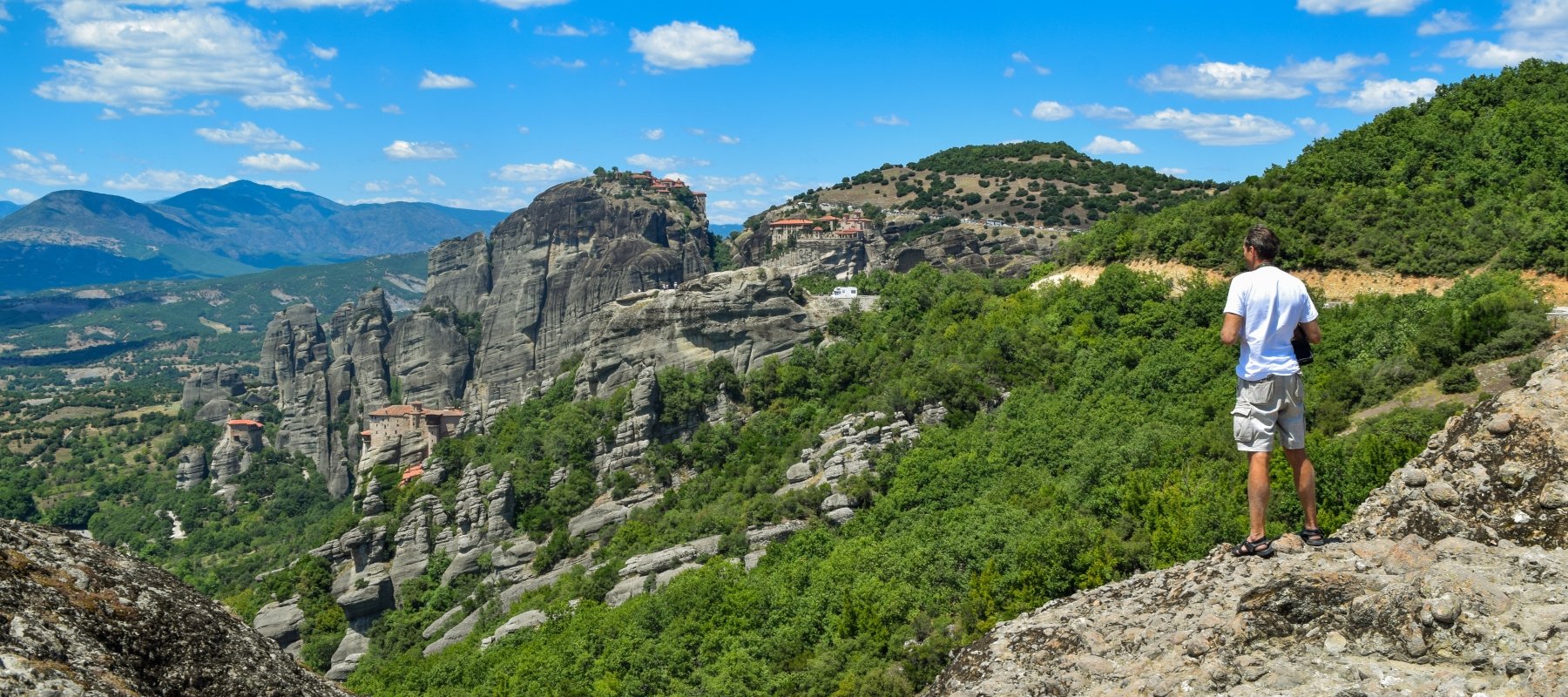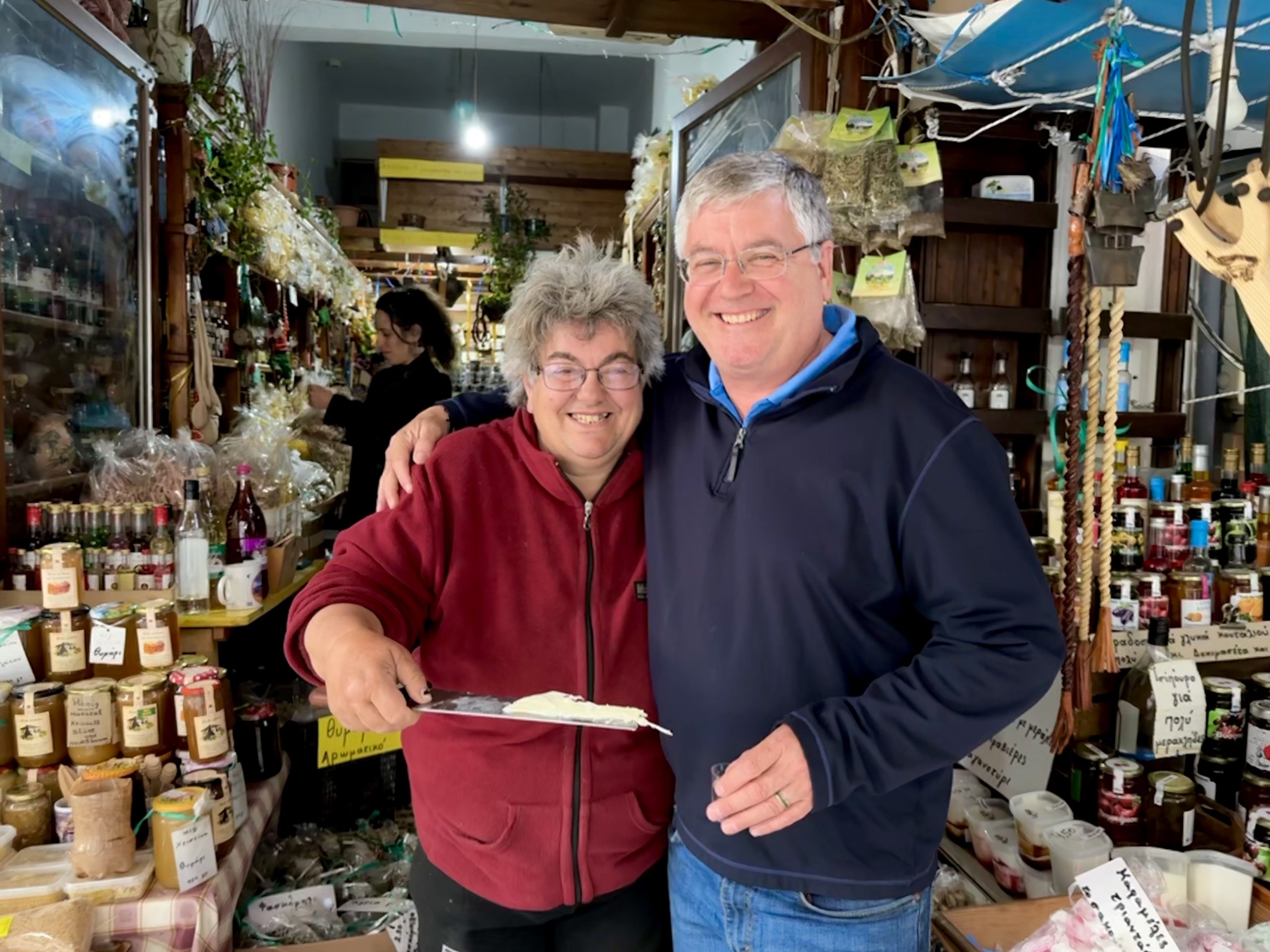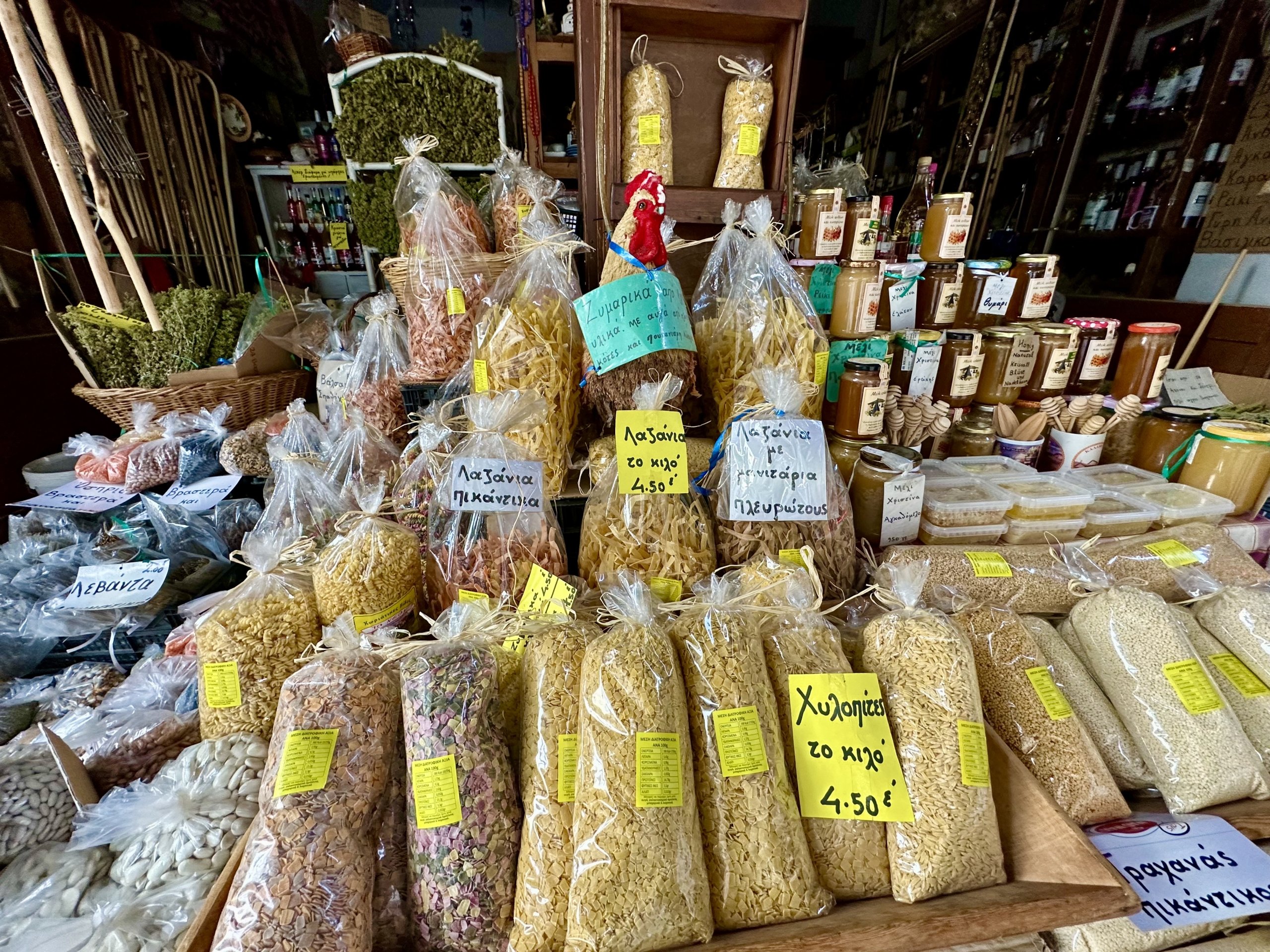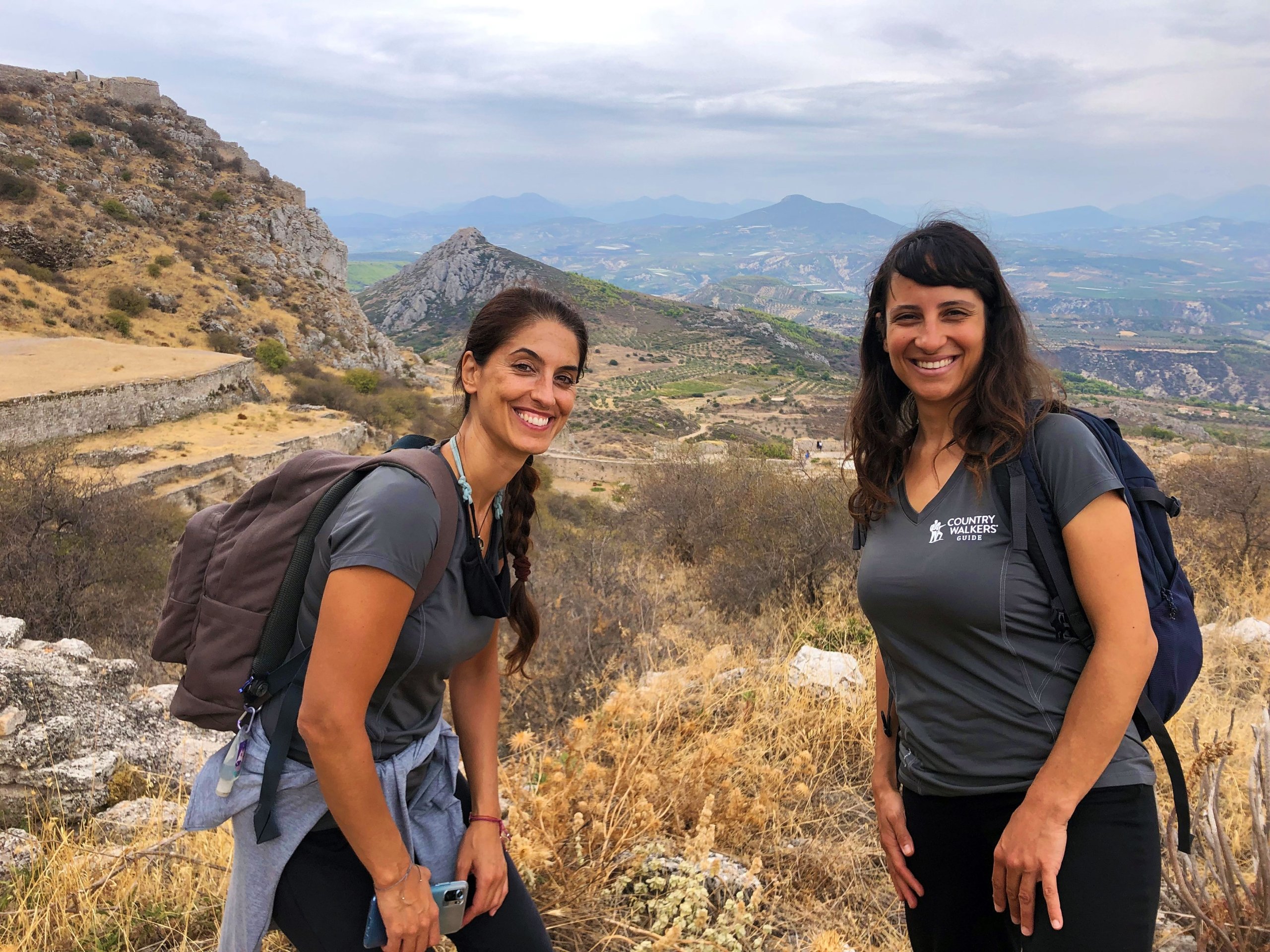From ancient to modern, from alpine landscapes to the sultry seashore, the stunning Country Walkers Greece: Athens, Delphi & Meteora Guided Tour brings many facets of Greek civilization to life. This is the perfect adventure for travelers who love coastal scenery and exquisitely fresh farm-to-table fare—as well as invigorating mountain hikes. Along with the tremendous diversity in the landscape, this adventure also offers an in-depth perspective on modern Greek identity, the history of ancient Greece, and Greek spiritual life in the stunning monasteries of Meteora.
The Elusive Identity of Modern Greece
Our journey begins on the Peloponnesian Peninsula—a fascinating and scenic coastal region. “During the first two days of your journey in the Peloponnesian Peninsula, you’re walking in a splendid natural environment, while also experiencing modern Greece,” explains Country Walkers Operations Manager Sandro D’Onofrio. “After the Turkish conquest in the 15th-century, the Greek people threw off the yoke of the conquerors in 1821 and began to reconstruct their vision of modern Greek identity. If you’re passionate about history, this is one of the most beautiful tours you can take because it gives you a deep view of the living history of Greece.” After centuries spent under Ottoman rule, it took time for modern Greece to rediscover and reclaim its culture—and in the process, the Greek people returned to their roots. As a result, the trappings of ancient Greek culture can be seen today in the local markets where rich handmade textiles and colorful ceramics are on display.
A two-night stay in the charming town of Kalavrita is the perfect way to experience modern Greek life in a quaint mountain village. “Kalavrita is an adorable little town,” recalls Country Walkers guest Melody Shaw. “We were there one evening after the shops had closed, and we were taking photos of the different things in the window because they had beautiful homemade crafts. And as we’re taking photos, one of our Country Walkers guides says, ‘Oh, we know the owners of this shop.’ Our guide calls out, the shop’s light flicks on, and a little old lady comes out.” After chatting with the local guides for a few moments, the shopkeeper invites the group inside a quaint emporium full of homemade pastas, liquors, and jars of fresh local honey. The guides explained that the shopkeeper and her husband are shepherds—and keep a flock of sheep and goats. “Once we’re inside, our new friend disappears into a back room and returns with a bottle of homemade tsipouro—a strong local liquor. She pours us each a shot, which we drink. She then disappears again and returns with a plate of fresh homemade goat cheese. Over another shot of tsipouro, she explains that she also keeps beehives—which she occasionally brings to the seaside so the bees can gather the orange blossom nectar there. She offers us samples of all the different honeys she makes—including pine honey, oak honey, thyme honey, and orange blossom honey. Just incredible!” Country Walkers guides live in the locations where they lead adventures—so they’re in the perfect position to introduce you to those authentic local experiences you wouldn’t find on your own.
Greek Theater and Ancient Oracles
Ancient Greece is often regarded as the cradle of Western civilization, and the nascent point for many modern concepts—including democracy, Western philosophy, and of course, theater. The tradition of Greek theater dates back to the year 542 B.C.E. when Thespis first read poetry in public. The thespian tradition was refined and elevated by subsequent Greek playwrights—including Aeschylus, Sophocles, and Aristophanes. This theatrical heritage is alive and well in modern Greece, as the local Country Walkers guides are delighted to demonstrate. “It’s really a fascinating way to walk through this ancient world,” says Sandro. “You’re immersed in a stunning landscape of olive groves and archeological sites. The guides really bring it all to life through their stories—and even a bit of playacting. Every day, Thalia and Katerina performed another exciting episode in their Greek history saga.” As the group was walking into Delphi, these creative guides enacted a scene depicting the moment when Zeus unleashed two eagles to find the navel of the world—a sacred point called the ‘omphalos’ in ancient Greece. Legend has it that one eagle flew east and the other flew west, eventually meeting in Delphi where the Temple of Apollo was built. “Our guides did an amazing job of acting out that legend—as well as many other little skits from Greek history along the way,” says Sandro. “The whole feeling with the landscape, the guides acting out stories, the ruins, and the languages that you hear—it really makes you feel that you are traveling back in time.”
In the ancient world, Delphi was a pilgrimage site to which people would walk long distances to honor the gods and seek guidance from the Delphic Oracle. Along the Sacred Way at Delphi, each Greek city-state built a house, similar to an embassy, reflecting the unique character, colors, and artistic expression found there. “Here, you can walk past the building that represents Sparta, and another for Thebes, another for Crete, and so on,” observes Sandro. “Each of them is different in style, and you’ll see statues and art they used to decorate each building.” As your Country Walkers guides lead you along the Sacred Way towards the Temple of Apollo, you’ll pass the many proud houses and monuments of the Greek city-states.
Reaching Towards Heaven: The Sublime Stone Pillars of Meteora
The remarkable landscape of Meteora was attractive to ancient religious hermits and spiritual ascetics seeking solitude among the caverns and fissures of the lofty stone pillars that loom above the landscape. The stunning elevation of these impressive sandstone monoliths made it possible for hermits to live a life of solitude and reflection in relative safety from marauders. Prompted by the Ottoman conquest of Greece in the 15th-century, new monasteries were constructed at Meteora to protect Greek Orthodox religious life from the ravages of war. “The monasteries are truly amazing,” recalls Sandro. “Although in modern times there are steps to reach the top, in the old days there were no steps—so the monks had to be hauled up the steep cliffs using a system of ropes and nets. It’s amazing to think about! When you reach the top, there’s an intense feeling of silent reverence that is truly humbling. With stunning views all around, you begin to understand how the monks could be here in this place, so far from secular concerns—and perhaps even feel a little closer to the divine.” With included visits to the Holy Church of the Dormition of the Virgin Mary, the Monastery of the Holy Trinity, and the Holy Monastery of Varlaam (and an optional visit to the Great Meteoron Monastery) you’ll find the mysteries of this spiritual center unfolding before you.




